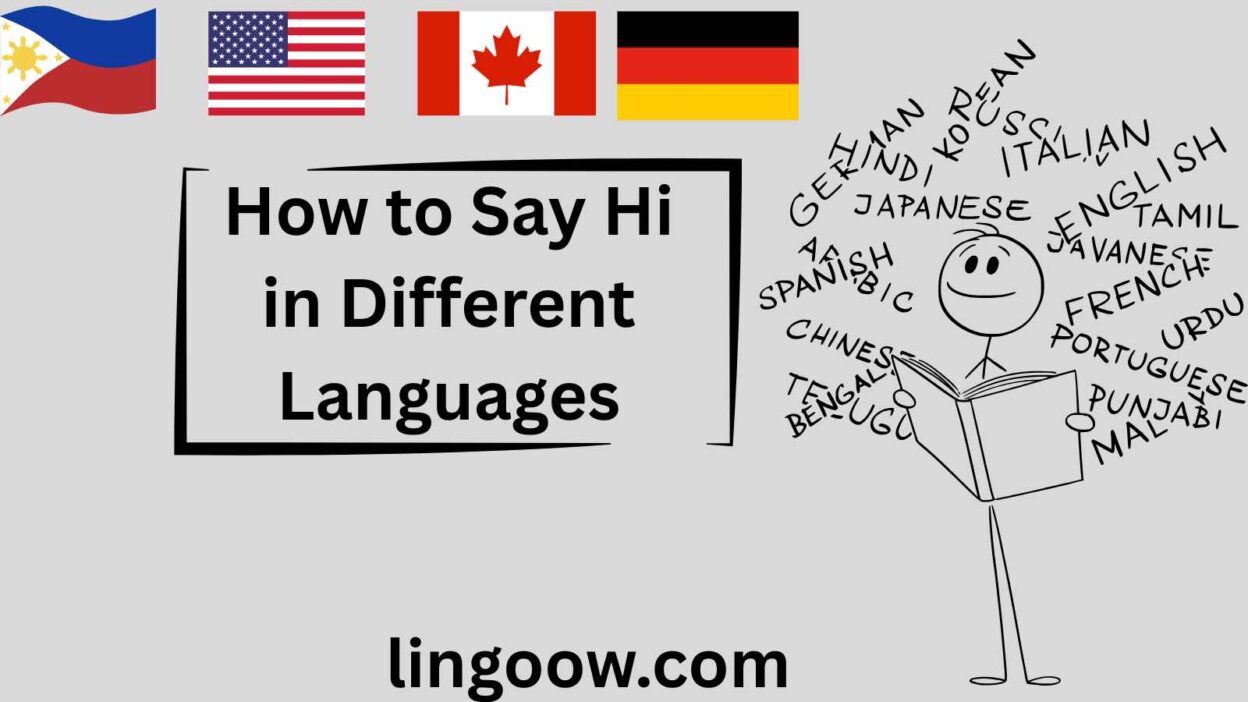Imagine standing in a bustling market in Marrakech, a quiet temple in Kyoto, or a vibrant festival in Rio de Janeiro.
Amid the kaleidoscope of sights, sounds, and smells, one simple word can bridge the gap between strangers: “Hi.”
This small greeting, so easy to say, carries immense power. It’s a spark of connection, a gesture of openness, and a universal invitation to engage.
I remember my first trip abroad, nervously stammering “Hola” to a street vendor in Barcelona.
Her smile in response felt like a warm embrace, proving that a single word can transcend borders and cultures.
The act of saying “hi” is a shared human experience, a thread that weaves through every corner of the globe, uniting us in our desire to connect.
In this article, we’ll embark on a journey to explore how “hi” is expressed in different languages and cultures. From the lyrical greetings of Europe to the intricate salutations of Asia, the vibrant expressions of Africa, and the soulful hellos of indigenous and island communities, we’ll uncover the beauty and diversity of this simple word. Along the way, we’ll dive into cultural insights, historical roots, and even proverbs that reflect the profound significance of a greeting. Let’s discover how the world says “hi” and what it reveals about our shared humanity.
A Global Greeting Table
Here’s a reference table showcasing how to say “hi” in 15 languages, complete with cultural or linguistic insights to provide a glimpse into their unique contexts.
| Language | Word/Phrase for “Hi” | Cultural/Linguistic Insight |
| French | Bonjour | Used throughout the day, “Bonjour” is formal yet warm, reflecting French emphasis on politeness. |
| Spanish | Hola | A versatile greeting used in both casual and formal settings across Spanish-speaking countries. |
| Italian | Ciao | Informal and friendly, “Ciao” is used for both hello and goodbye, embodying Italian warmth. |
| German | Hallo | Straightforward and widely used, “Hallo” reflects German efficiency in communication. |
| Mandarin | Nǐ hǎo | Literally “you good,” it’s a polite greeting that emphasizes harmony in Chinese culture. |
| Hindi | Namaste | A respectful greeting with spiritual roots, often accompanied by a slight bow with palms pressed together. |
| Japanese | Konnichiwa | Used in the afternoon, it reflects Japan’s time-specific greetings and cultural precision. |
| Korean | Annyeong | Informal and friendly, it’s a common greeting among peers, showcasing Korean warmth. |
| Arabic | Marhaban | A welcoming greeting used across the Arab world, often paired with hospitality gestures. |
| Swahili | Jambo | A cheerful greeting common in East Africa, symbolizing community and connection. |
| Zulu | Sawubona | Literally “I see you,” this greeting emphasizes recognition and respect in Zulu culture. |
| Yoruba | Bawo ni | A friendly inquiry meaning “how are you,” reflecting Yoruba’s conversational warmth. |
| Maori | Kia ora | A versatile greeting meaning “be well,” deeply tied to Maori values of health and community. |
| Hawaiian | Aloha | A multifaceted word meaning love, peace, and hello, embodying the spirit of Hawaiian culture. |
| Cherokee | Osiyo | A warm greeting that reflects Cherokee traditions of community and respect for others. |
European Languages: A Tapestry of Greetings
In Europe, greetings are as diverse as the continent’s history and landscapes. In French, “Bonjour” is more than a word—it’s a cultural cornerstone, used from morning to evening to show respect and warmth. In France, failing to say “Bonjour” when entering a shop can be seen as rude, highlighting the importance of acknowledging others. Spanish speakers use “Hola” with a smile, whether greeting a friend in Mexico or a stranger in Spain. Its simplicity makes it a universal connector across the Spanish-speaking world. In Italy, “Ciao” rolls off the tongue with effortless charm, reflecting the country’s love for casual, heartfelt interactions. It’s used for both hello and goodbye, making it a linguistic hug. German “Hallo” is direct and efficient, much like the culture itself, but don’t mistake its brevity for coldness—it’s a warm invitation to connect. In Portuguese, “Olá” carries the same spirited energy in Portugal and Brazil, often paired with a nod or a wave. These greetings, while varied, share a common thread: they open the door to human connection, reflecting Europe’s rich tapestry of social norms and warmth.
Asian Languages: Harmony in Diversity
Asia, with its vast array of cultures and languages, offers a fascinating lens on greetings. In Mandarin, “Nǐ hǎo” (你好) is a polite and formal way to say hi, used in China and beyond. Its literal meaning, “you good,” reflects a cultural emphasis on well-being and harmony. In Hindi, “Namaste” transcends a simple hello; it’s a spiritual greeting, often accompanied by a bow and pressed palms, symbolizing respect and unity in India and Nepal. Japanese “Konnichiwa” is time-specific, used in the afternoon, showcasing Japan’s nuanced approach to greetings that align with the time of day. In Korean, “Annyeong” is a casual, friendly hello, perfect for peers, while more formal settings might call for “Yeoboseyo” when answering the phone. Arabic “Marhaban” is a warm welcome used across 20+ countries, from Morocco to Iraq, often paired with gestures of hospitality like offering tea. In Thai, “Sawasdee” is a versatile greeting used for all times of day, reflecting Thailand’s easygoing warmth. These greetings, spanning countries like Vietnam (“Xin chào”), Indonesia (“Halo”), and the Philippines (“Kumusta”), highlight Asia’s diversity while emphasizing respect, harmony, and community.
African Languages: Greetings with Soul
Africa’s linguistic diversity shines through its greetings, each carrying deep cultural significance. In Swahili, spoken across East African countries like Kenya, Tanzania, and Uganda, “Jambo” is a cheerful hello that fosters community. It’s often the first word travelers learn, symbolizing Africa’s welcoming spirit. Zulu, spoken in South Africa, uses “Sawubona,” meaning “I see you.” This greeting is profound, acknowledging the other person’s presence and humanity, a value central to Zulu culture. In Yoruba, spoken in Nigeria and Benin, “Bawo ni” is a friendly “how are you,” inviting conversation and connection. Amharic in Ethiopia uses “Selam,” a simple yet warm greeting tied to peace. Across 20+ African countries, from Hausa (“Sannu” in Nigeria) to Shona (“Mhoro” in Zimbabwe), greetings are more than words—they’re expressions of respect, community, and shared humanity, often accompanied by handshakes or smiles that bridge cultural divides.
Indigenous & Island Languages: Greetings from the Heart
Indigenous and island languages offer unique perspectives on greetings, rooted in tradition and connection to the land. In Maori, spoken in New Zealand, “Kia ora” means “be well,” a greeting that reflects a holistic view of health and community. It’s often used in formal and informal settings, embodying Maori warmth. Hawaiian “Aloha” is a world-famous greeting that carries layers of meaning—love, peace, and compassion—used across the Hawaiian Islands. In Cherokee, spoken in parts of the United States, “Osiyo” is a warm hello that honors community and respect, often used in tribal gatherings. Samoan “Talofa,” used in Samoa and American Samoa, is a joyful greeting that invites connection. Across 20+ indigenous and island communities, from Inuit (“Alya” in Canada) to Chamorro (“Håfa ådai” in Guam), these greetings are deeply tied to cultural identity, often reflecting values of respect, nature, and togetherness.
Cultural Insights: The Evolution of “Hi”
The word “hi” and its equivalents have evolved over centuries, shaped by cultural, religious, and historical forces. In English, “hi” is a shortened form of “hiya,” which emerged in the 19th century as a casual greeting. Its simplicity reflects the practicality of English-speaking cultures. In contrast, greetings like “Namaste” in Hindi or “As-salamu Alaikum” in Arabic (meaning “peace be upon you”) carry spiritual weight, rooted in religious traditions that emphasize peace and respect. In Japan, time-specific greetings like “Konnichiwa” or “Ohayo” (good morning) reflect a cultural precision tied to historical social hierarchies. In African cultures, greetings like “Sawubona” emphasize communal recognition, a practice that dates back to oral traditions where acknowledging someone’s presence was a sign of respect. These variations show how greetings are more than words—they’re cultural artifacts, carrying the weight of history and values.
Proverbs and Sayings: Wisdom in Greetings
Greetings often inspire proverbs and sayings that reflect their cultural importance. In Swahili, the saying “Hujambo usipojambo” translates to “You are well if you greet well,” emphasizing the role of greetings in fostering harmony. In Arabic, “A kind word opens doors” reflects the value of a warm greeting like “Marhaban” in building relationships. A Japanese proverb, “Ichigo ichie” (“one time, one meeting”), reminds us that every greeting is a unique moment of connection. In Maori culture, “He tangata takahi manuhiri, he marae puehu” (“A person who mistreats a guest has a dusty marae”) underscores the importance of welcoming others with greetings like “Kia ora.” These sayings reveal that greetings are not just formalities but acts of kindness and respect that shape human bonds.
FAQs: Unraveling the Mystery of “Hi”
Why do greetings sound similar in many languages?
Many greetings, like “Hallo” (German), “Hola” (Spanish), and “Halo” (Indonesian), share phonetic similarities due to linguistic evolution and cross-cultural exchanges. Simple syllables like “ha” or “ho” are easy to pronounce and have been adopted across languages.
What is the oldest known greeting?
While exact origins are hard to trace, greetings like “Shalom” (Hebrew) and “As-salamu Alaikum” (Arabic), both meaning “peace,” date back thousands of years, rooted in ancient Semitic languages and religious texts.
How do cultural differences shape greetings?
Cultures prioritize different values in greetings. For example, Japanese greetings emphasize time and hierarchy, while African greetings like “Sawubona” focus on acknowledgment and community. Physical gestures, like bowing in Japan or handshakes in Nigeria, further reflect these differences.
Conclusion: The Heartbeat of Humanity
Saying “hi” is more than a word—it’s a universal act of connection, a small gesture that carries profound emotional and cultural weight. From the respectful “Namaste” in India to the soulful “Sawubona” in South Africa, each greeting tells a story of its people, their values, and their history. Yet, despite their differences, these greetings share a common purpose: to acknowledge, to welcome, and to connect. They remind us that no matter where we are, a simple hello can spark a moment of shared humanity.
What’s your favorite way to say “hi”? Whether it’s a warm “Aloha” or a cheerful “Jambo,” share your experiences in the comments below. Let’s celebrate the beauty of greetings and the connections they create across the world!




